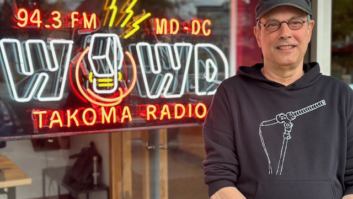
Bob Hoffman: “Here’s what you need to know about social media. The hundreds of millions of people using social media are interested in interacting with each other. Not ads. Not brands. Not you. Not me.”
credit:
© Radio Show Didn’t make it to the fall Radio Show convention? Or maybe you just hung around the floor and the tech sessions? Here are excerpts of a speech you wish you had heard.
Bob Hoffman of consulting firm Type A writes about advertising and runs The Ad Contrarian blog.
We begin our journey in 2004. If you recall, about 10 years ago, pundits started to declare that advertising was dead.
Seth Godin, the best-selling guru of marketing, said, “We have reached the end of traditional advertising.” Advertising Age said, “The post-advertising age is under way.” In 2004, one of America’s most highly respected research firms, Forrester & Co., proclaimed that we had reached “the end of the era of mass marketing.” Apparently they forgot to tell Apple, who sold 200 million iTunes downloads that year and set the stage for the most mind-blowing explosion of mass marketing in history. By the beginning of 2013, they had sold 25 billion downloads.
Joseph Jaffe in his successful book “Life After the 30-Second Spot,” said this in 2005: “Now is the time to come out of my closet with this emphatic statement: The 30-second spot — at least as it exists today — is either dead, dying or has outlived its usefulness. Take your pick.”
Bob Garfield, a columnist at Advertising Age, said in 2009, “The present is apocalyptic. Any hope for a seamless transition — or any transition at all — from mass media and marketing to micro media and marketing are absurd. The sky is falling, we are, exquisitely, irretrievably f—d.”
Bob’s a nice guy, but I really think he needs a hug.
And, according to the nonprofit think tank, FutureLab — they just came right out and said it, quote: “Advertising is dead.”
So, here’s my dilemma. I’m confused. Everywhere I look I see advertising.
It’s on every gas pump, every T-shirt, every bus bench, every napkin, coaster, grocery receipt, milk carton, boarding pass, theater ticket and dry cleaning bag. Every square inch of the f—g planet is covered in advertising … and these schmucks are telling us it’s dead.
In fact, in 2012 and 2013, U.S. advertising expenditures reached all-time highs.
If our economy was growing at the same rate as advertising, we’d be dancing in the streets …
Now one of the reasons traditional advertising was going to die was because of interactivity. You see, interactivity was going to make marketing so much more engaging and effective. Interactive advertising was going to disrupt the old forms of advertising and make them obsolete. (By the way, a marketing person is no longer permitted — by law — to finish a sentence without using the word “disrupt.”)
Well, as luck would have it, it turns out that consumers have no interest whatsoever in interacting with advertising. In fact, online banner ads have a click-through rate lower than one in a thousand. This is not interactivity. This is absence of interactivity. …
What’s worse, among the few clicks that do occur, an astounding amount are fraudulent. According to a report by CNET, only 38 percent of traffic on the Web now is human. The rest are bots, scrapers, hackers, spammers and other impersonators. And the amount of fraud being perpetrated on advertisers by online scammers is alarming. …
Then, of course, social media was going to kill advertising. … When I talk about the bullshit of social media marketing, I am not speaking as a social media denier, I am speaking as one of its successful practitioners.
Social media itself is a huge worldwide phenomenon. There’s no question about that. But social media marketing has been anything but.
We’ve all read a thousand articles about the magical power of social media marketing. Let me just quote a few.
According to USA Today, “Social media is the lone currency that virtually guarantees a return.” One of America’s great geniuses from Sequoia Capital had this to say: “If you can harness social media marketing, you don’t have to pay for advertising anymore.”
Bullshit.
JUST ONE MORE CHANNEL
In fact, what social media sites are rapidly becoming is just one more channel for delivering traditional paid advertising. Take another look at your Facebook page. It’s swimming in traditional, paid ads. Count the number of paid ads and compare it to the number of “conversations about brands.”…
Perhaps the most stunning report on the ineffectiveness of social media marketing was issued just a few months ago by McKinsey & Company, the consulting firm. This one sentence from their report says it all: “Email remains a more effective way to acquire customers than social media — nearly 40 times that of Facebook and Twitter combined.”
This past summer, the social media delusion really took a beating.
A few weeks ago The Wall Street Journal ran a story headlined “Social Media Fail to Live Up to Early Marketing Hype.” The San Francisco Chronicle ran with “Tweets and Likes Don’t Translate Into Buys.” CNBC weighed in with this story: “Facebook Brand Engagement Plummets, Study Shows”
And finally, even Facebook — the face of social media — where the tired old ways of traditional advertising were coming face-to-face with the brave new world of the social consumer — has given up on the fantasy of social media marketing.
Here’s what the New York Times had to say last month: “A few years ago, [Facebook] was telling brands to increase the number of people following their pages. Now it says fans are largely irrelevant.”
Finally, Facebook and I agree about something.
Here’s what you need to know about social media. The hundreds of millions of people using social media are interested in interacting with each other. Not ads. Not brands. Not you. Not me.
Now I’m sure some of you are skeptical of my point of view, so I want to invite you to become scientists this weekend. Do a little experiment.
Go to the biggest supermarket in your neighborhood. Then go to Target. Then go to Walmart. Walk up and down the aisles. Make a list of all the products and all the brands you can find that were built by online advertising or social media. All the brands of toothpaste and toasters and beer and cereal and soap and soda and snacks and cheese and shampoo and tomato sauce and tuna and tea and tires.
I think you’ll find what I found. You have an empty piece of paper.
And while the experts were lecturing us on the magic of online advertising, they were also prophesizing the death of broadcast advertising.
We were told that TV was dead. First, the DVR was going to kill it. … If the DVR didn’t kill TV, the Web would. You see TV and the Web were going to converge (you remember convergence, right?). …
Now let’s look at the facts. Despite the bullshit of all these experts, in the third quarter of last year, 97 percent of all video viewing in the U.S. was done on a television, 3 percent was done online.
And finally, of course, there’s radio. According to Fox News, “iTunes and friends have nearly killed off the radio.” And according to The Street, “AM/FM Radio Officially Dead.”
Bullshit.
According to the latest reports from Nielsen, radio is almost three times as popular with consumers as the Web.
A recent study reported in Ad Age showed that radio advertising is substantially more effective at creating sales than online advertising.
In addition, radio has none of the harrowing advertising fraud problems that the Web has.
And you know where and when your ads are running — unlike the Web, in which no one has any idea where their ads are running. According to the New York Times, even media buyers have no idea where the online ads they buy wind up.
Now I have a very fond place in my heart for radio. I built my career on it. My first successes in advertising were in writing jingles for radio, and virtually every client I put on radio during my career I had success with.
But I have a bone to pick with you guys.
I think you guys are letting the online industry eat your lunch.
The trade press and the ad industry have created a narrative and regardless of the facts, the narrative lives. And you’re letting it live.
I think you and the TV industry have been way too timid in your reaction to the online ad industry. I think you’ve been letting them get away with murder with all their bullshit, and I don’t know why you aren’t hitting them hard and often.
I’m not naïve. I know most of you have online inventory to sell along with your radio inventory. I know that multi-platform selling is becoming a part of your business. And I know you don’t want to undermine your sales people.
But I think you can sell your online inventory without letting the online industry get away with murder.
What you need is a strategy. You need a strategy that operates on parallel paths.
The sales people need to sell the hell out of their multi-platform offering.
Simultaneously, it’s time for radio industry leadership — station management, corporate management and industry management — to take the gloves off.
The reason I am here today, and the reason I am frequently invited to conclaves like this, is because there is a very important and very compelling story to be told about the corruption and the inefficiency in the online world. You need to find a way to tell this story. Believe me, the agency community and the client community do not know it.
The longer you allow the misrepresentations and fictions to continue, the more damage you are doing to your business.
If you don’t have the backbone to defend yourselves, who will? You know, people, I can’t do this alone. …
WE NEED TROUBLEMAKERS
The ad industry has developed a terrible habit of telling half the truth half the time. We speak in dreadful jargon that obscures what it pretends to clarify.
We’ve become too congenial, too respectable and too polite.
We need to challenge the experts. We are in desperate need of troublemakers.
We need people who aren’t afraid to get up on stage at the next “big data” or social media conference and pull their pants down.
We need the kind of quarrelsome, pugnacious, opinionated people that make the arts vibrant and interesting.
Are things changing? Of course they are. Things are always changing. Are there problems? Sure, there are. There are always problems.
But that’s no excuse for the ad industry — an industry that’s supposed to be creative and forward thinking — to sit back and operate on unreliable and irresponsible baloney that is hyped, promoted and amplified by people who have been wrong over and over and over.
My friends, we have been through 10 years of insufferable bullshit and I for one am tired of it.
The full text of Hoffman’s speech, including remarks about the value of the over-50 consumer demographic, is available athttp://bit.ly/1qKJQZw.
Comment on this or any story. Write to [email protected].












